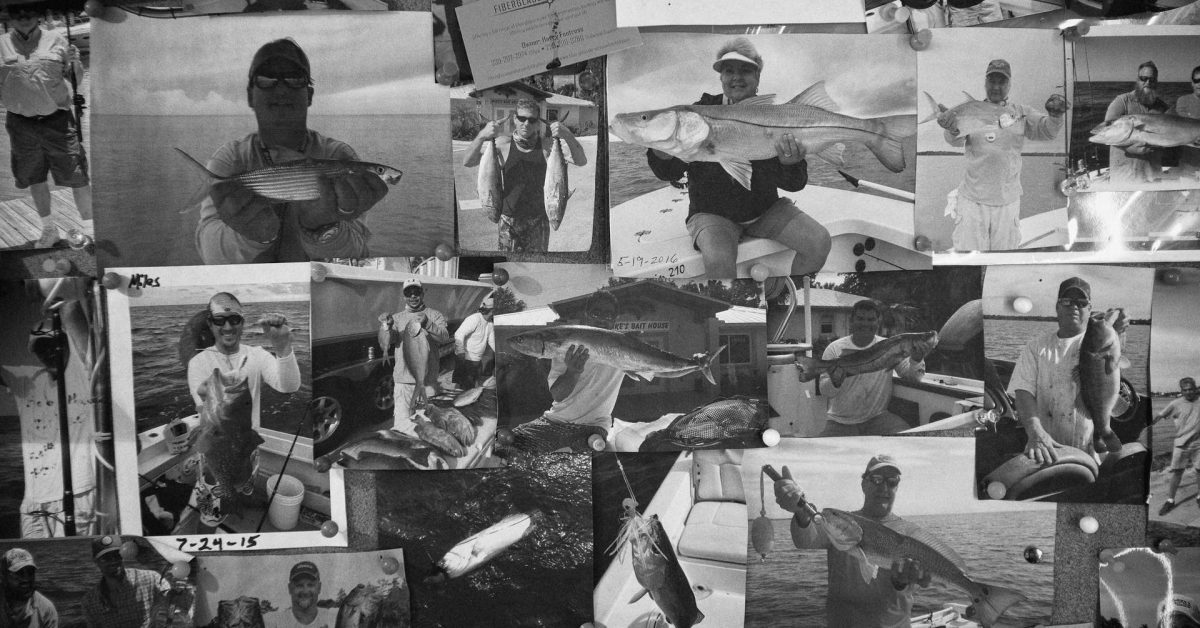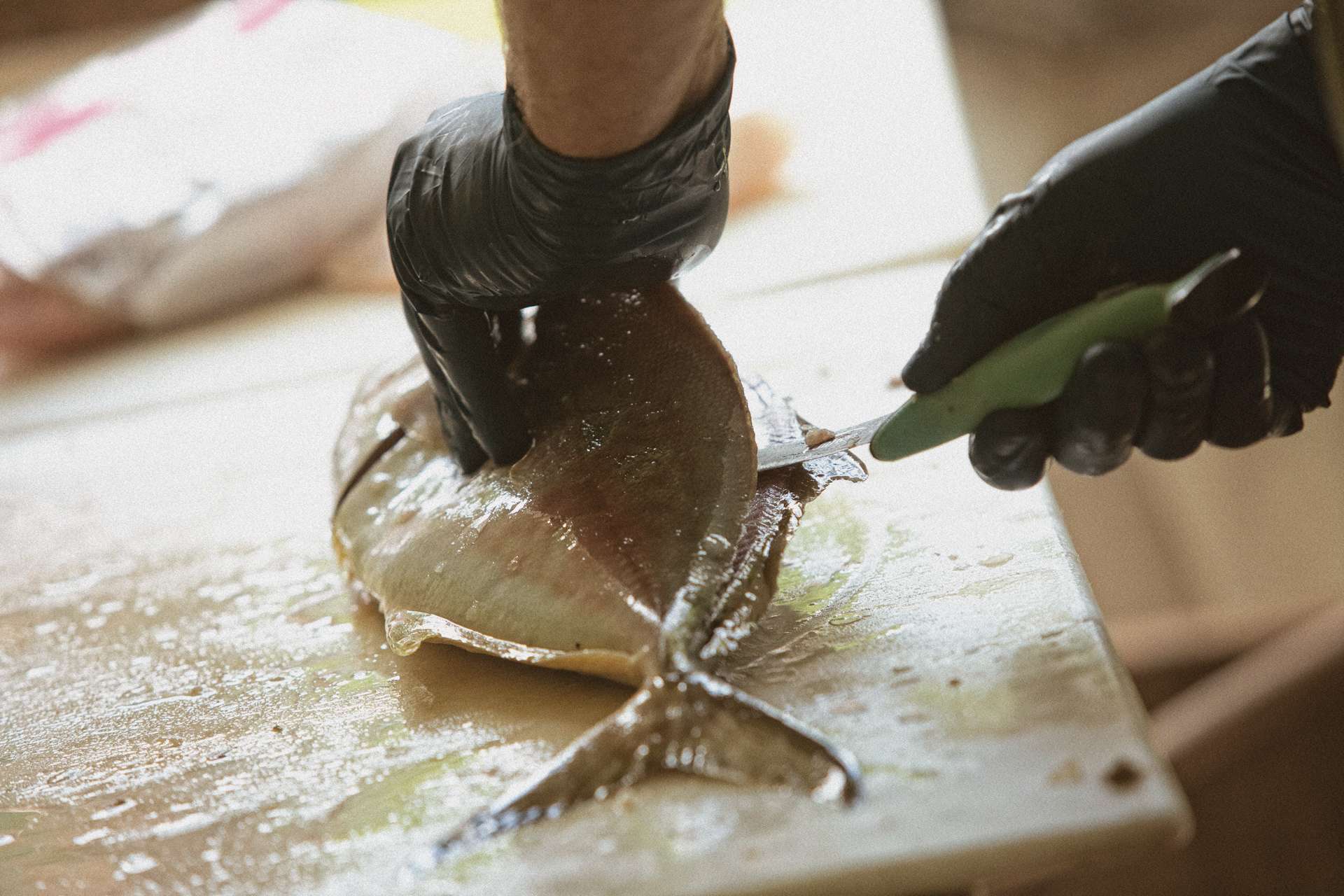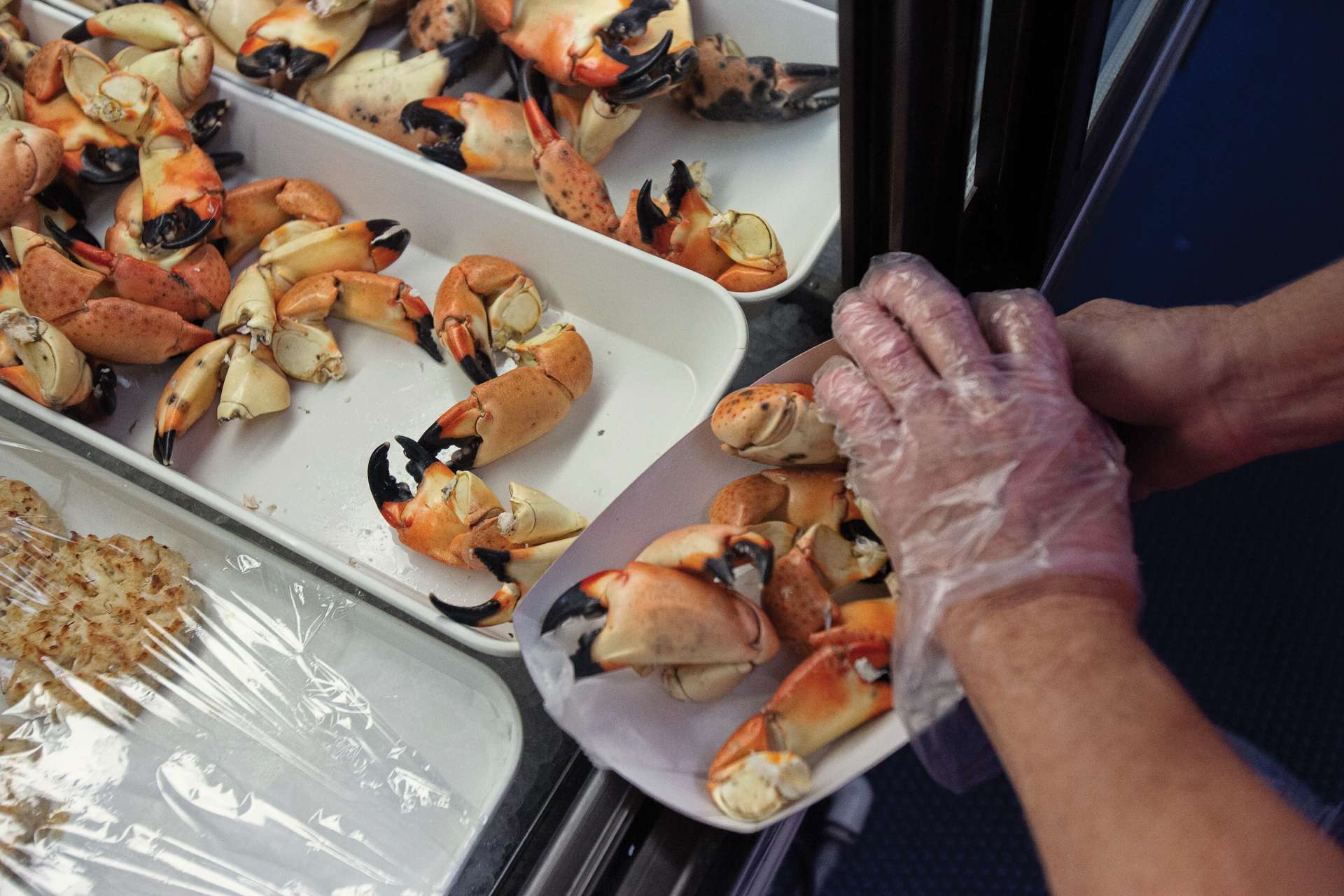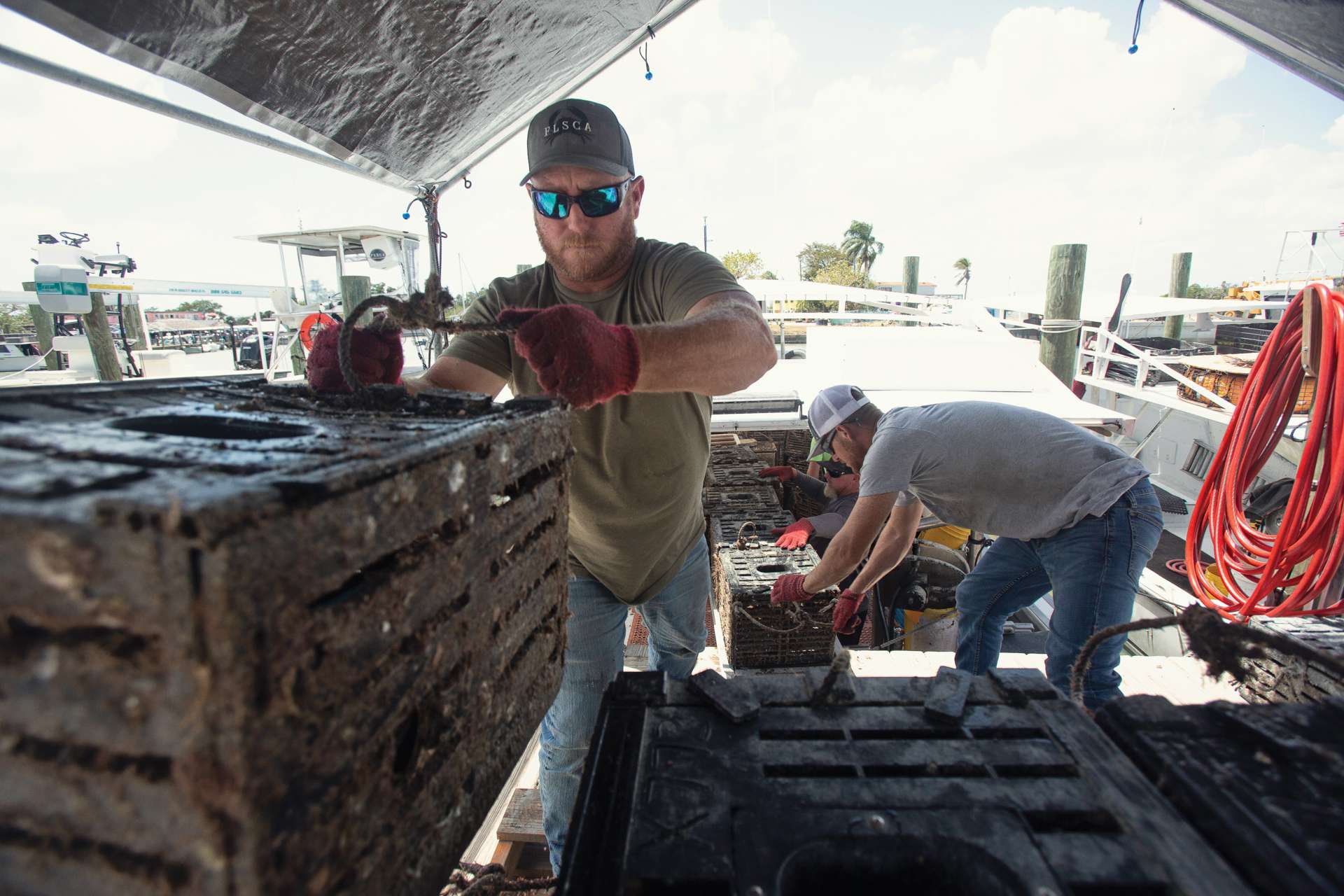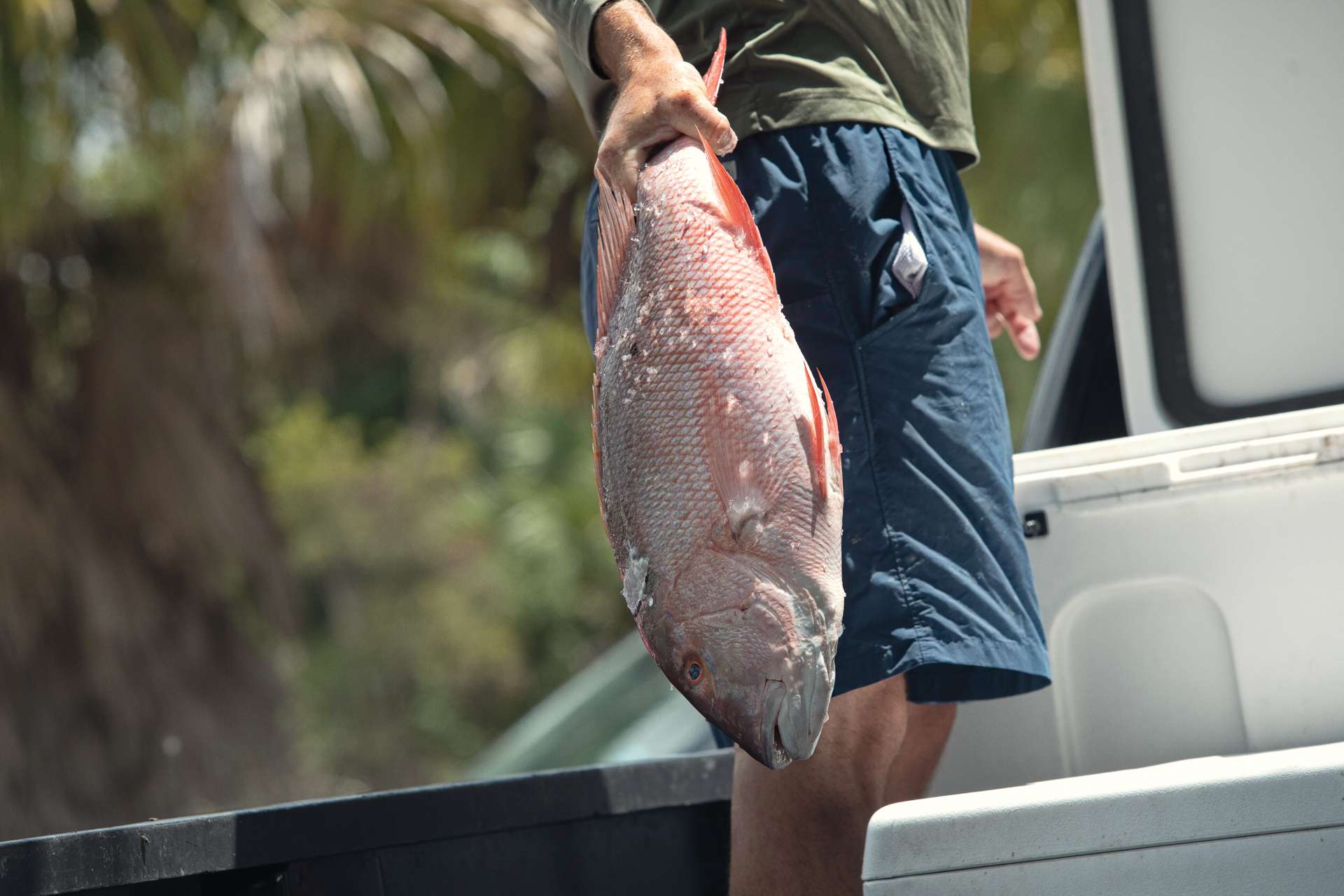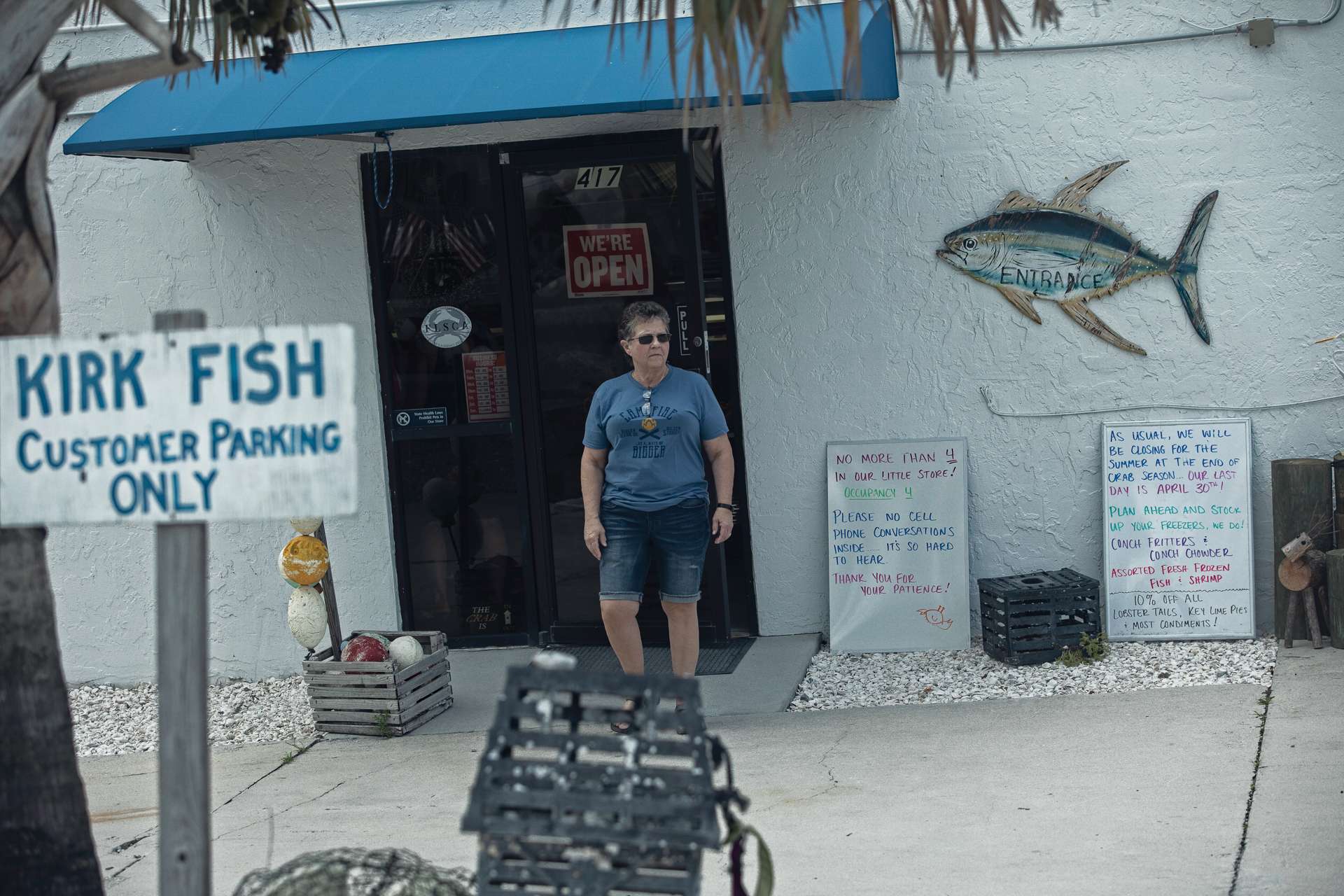Fresh Local Seafood
It’s just after noon on an unseasonably warm Friday in early spring. Naples has had a string of cold days and now this hot one, but no one standing in line in front of Mike’s Bait House in East Naples seems to mind. The line extends from the street, where cars are parked nose-to-bumper. It snakes through the parking lot and winds beside a black extended-cab Chevy. In the back of the truck, two young men from Dilly’s Fish Co.—owned by Tim “Dilly” Dillingham—lean over Grizzly coolers.
“What’s the difference between a lane snapper and a red snapper?” a man in line calls out.
“A red snapper’s going to be a little more firm,” one of the young men in the back of the truck answers. That’s Dominick Biagetti, Dillingham’s right-hand man. Biagetti serves as boat captain and crew, and he helps with offloading and delivery. He has a seascape tattooed on his leg, an underwater reef scene with a turtle and a moray eel.
“How about a mangrove snapper?” the man on the ground calls back.
“The mangrove snapper is going to have a thicker bloodline.”
“A what?”
“A bloodline.” Biagetti pulls a mangrove snapper out of the cooler and leans over the side of the truck to show him what he means.
The other young man pulling fish out of the coolers is Ethan Olah, a mate on Dillingham’s boat and one of the most accomplished spearfishermen in Florida. “The giant fish he shoots on my boat are unbelievable sea monsters,” Dillingham tells me later.
Beside the black Chevy, a white board lists the day’s catch: red grouper, gag grouper, almaco jack, banded rudderfish, red snapper, mangrove snapper, vermillion snapper, triggerfish, lane snapper. In line, a man in loafers cranes his neck to read. “What else is crossed off besides the black grouper?” he asks. Behind him, two men are also reading the board. “They’ve got stone crab, too,” one of them says to his buddy.
“I’m not real wild about stone crab,” the buddy says. “I’d rather have lobster.”
“You know, I wouldn’t order it in a restaurant,” the first man says. “It’s just so dang expensive. But at a place like this … ”
At the head of the line, a man with an Eastern European accent is discussing the fish he’s about to purchase. “It’s six pounds,” a young woman dressed in a black visor and white sun shirt says, pulling the fish off the scale. That’s Alex Plonka, Dillingham’s long-time girlfriend. She runs the sales at the fish market. “Do you want us to clean it for you?”
“Please,” the man says.
“Skin on or skin off?”
“Skin on and keep the head.”
In the line that extends to the road, people stand and sit on coolers. Young couples in yoga clothes. Older gentlemen dressed for golf. Women in Tod’s and designer sunglasses. A dachshund on a leash looks around curiously. Some people have brought snacks; they plan to be here a while. Others open their coolers and compare interiors. “Oh, there’s my cast net,” one man says. The air smells vaguely like mosquito spray. Then the wind shifts and there it is—the smell of fresh fish, not fishy at all but like the sea itself.
One of the strangest paradoxes of Southwest Florida is that we’re a community perched on the edge of the Gulf, yet so much of our seafood is imported from other places. Some of it comes from Mexico and Central America; some of it comes from Europe; some of it comes from the Pacific Northwest. Not much of it comes from the waters that are virtually at our front door. That’s why people come to Dilly’s from three counties, cash in one hand and a cooler in the other, happy to stand in line all morning for a shot at buying fresh local seafood. The once-a-week market in front of Mike’s Bait House accounts for about 20% of Dillingham’s business. The other 80% goes to many of the finest restaurants and country clubs in Naples.
In the bait house parking lot, Biagetti holds up a triggerfish for the woman at the head of the line. “Is this your first trigger?” he asks her. The woman nods. “The skin’s really tough,” he says. “You got to almost clean it backward. Start at the butt, come underneath, run all the way down. Otherwise, you’ll dull your knife 10 times over trying to cut through the skin.”
Everybody within earshot leans forward, listening as if he’s speaking from the gospel.
“You must eat fish a lot,” the woman buying the triggerfish says to him.
Biagetti pauses for just a moment to shake his head. “We sell out every week.”
Long Hours, High Costs
At his weekly fish sale, Dillingham stands at the fish cleaning station behind Mike’s Bait House filleting fish for his customers. He looks, at 46, like a man who has enjoyed a life on the water; tanned and strong, with the kind of easy-going vibe that comes to those who spend their days surrounded by waves and salt air. Though Dillingham grew up fishing in Michigan, he’s relatively new to the Florida commercial fishing business. This is his eighth year as a fisherman focused on a variety of grouper and snapper species (as well as cobia, African pompano, porgy, hogfish, triggerfish, almaco jack, yellow jack and amberjack). Before that, he spent two years diving for lobster. And before that, he got up every day, put on a suit and tie and went to work in the financial industry. But he didn’t love corporate life. “It just wasn’t me,” he says.
He moved to Naples in 2001 to work in the mortgage industry. After the collapse of the real estate market in the mid-aughts, he took a job on Big Pine Key. That’s where he came across a guy who owned a commercial lobster operation. The two got to talking. Dillingham was a certified scuba diver, the guy could use some extra help, so Dillingham started spending his weekends diving for lobster.
He quickly realized that there was a need for fresh local seafood in the Naples area. “The key word is fresh,” he says. “Most seafood being served in restaurants is coming from Mexico and other places in Central America. What we’re doing—especially our time frame—is pretty rare.”
Dillingham and his crew make only daylong and overnight trips, ensuring that their fish is never more than one to two days out of the water. He runs a 27-foot Onslow bay boat with twin 300-horsepower Mercury Verado engines—he never named it, so it goes by “Dilly’s Fish Co.”—that’s docked in front of his house on the Imperial River. He makes one to two fishing trips each week, depending on weather. Each trip is usually two days offshore.
Dillingham’s trips start before sunrise. Sometimes he, Biagetti and Olah are joined by his friend Kevin Weber or his dad, Ron Dillingham—aka Jurassic Dilly. Their objective: Get as far offshore as they can, as quickly as possible. The men fish all day and most of the night, using both rod and reel and spear, aided by scuba equipment that lets them dive 110 to 200 feet deep. Sometimes they’ll lie down for two to three hours in a couple of bean bag chairs on the boat, but they’re up at first light to fish and dive again. They fish until the boat is full or they start to run low on ice, then they head back to shore just after dark on the second day. Most trips run 35 to 40 hours from the time they leave the dock to the time they motor back in. “It’s a hard job,” Dillingham says. “We get our asses kicked out there.”
These trips come at a high cost. In March, he paid more than $1,000 to fill the boat’s tank with gas. That same month, an electrical fire offshore did enough damage that the boat had to be docked for days. And the increasing price of licensing and quotas is slowly eroding his already slim margins.
It’s this last item that has Dillingham the most concerned. He worries that the costly regulations on commercial fishing in the Gulf of Mexico will destroy his business. In fact, he thinks they might ultimately doom the entire industry.
An Industry on the Rise … and Fall
For those of us who grew up in the coastal communities of Southwest Florida, commercial fishing was an ever-present part of life. On Fort Myers Beach, the guys who worked at the fish houses turned up at the grocery store in their white rubber boots, a lit cigarette in hand. The elementary school was filled with the kids of shrimpers. The fleet was always coming and going from the wharf. But those days are long over.
Florida’s commercial fishing industry peaked in the 1950s. Afterward, commercial fleets began to face a number of threats: Cheap imported seafood flooded the market; the price of gas skyrocketed; regulations went into effect to protect depleted Gulf fisheries.
“It’s an industry where fishermen face significant challenges,” says Dr. Shelton Weeks, director of the Lucas Institute for Real Estate Development and Finance at Florida Gulf Coast University. “The big positive when you think about fishermen here in Southwest Florida is the quality of the product. Our fresh local seafood is world-class. That ultimately keeps them viable.”
Today, the commercial fishing industry remains an important part of the Florida economy. According to a 2016 report from the Florida Department of Agriculture, the most recently available data, Florida’s seafood accounted for 3.16% of total annual agricultural receipts for the state. Florida ranked 11th in the United States for fresh seafood production. Florida fishermen caught more than 80% of the nation’s supply of grouper, pompano, mullet, stone crab, pink shrimp, spiny lobster and Spanish mackerel. That translated to upward of 87 million pounds of fresh seafood, with a dockside value of $237 million. The seafood industry supported more than 4,000 jobs. But it still struggles.
Regulations’ Chokehold
The Gulf of Mexico’s fisheries are managed by the National Oceanic and Atmospheric Administration. NOAA takes recommendations from the Gulf of Mexico Fishery Management Council, one of eight U.S. regional fishery management councils established by the Fishery Conservation and Management Act of 1976. The Gulf Council is made of 17 voting members from the states that border the Gulf of Mexico—Florida, Texas, Louisiana, Alabama and Mississippi.
NOAA Fisheries and the Gulf Council have an impossible task: balancing the interests of commercial fishermen, recreational fishermen, marine scientists and the species that populate the Gulf. Their policies and recommendations rarely sit well with commercial fishermen such as Dillingham, who often see their votes as a vote against commercial fishing. “If things continue down the path they are on, we will no longer have commercial fishing in the Gulf in 20 years,” Dillingham says.
He makes a good case for it. In May 2022, NOAA Fisheries announced that it approved Amendment 53, which reallocates red grouper quota away from commercial fishermen in favor of recreational fishermen. Prior to the amendment, commercial fishermen were allocated 76% of the total quota, while recreational fishermen were allocated 24%. Amendment 53 changes that to 59.3% for commercial fishermen and 40.7% for recreational fishermen, effectively stripping commercial fishermen of 630,000 pounds of red grouper. For Dillingham, who relies on red grouper as part of his product list, that means he’s now paying $3.25 a pound to lease red grouper quota. Last year, he was paying 75 cents a pound.
“I understand why people hate commercial fishing,” Dillingham says. He points to documentaries including Seaspiracy from Netflix, which profiles overfishing in the world’s oceans. “But that’s not what’s happening in the Gulf. Gulf fishermen are out here sacrificing everything.”
The fact remains, however, that without regulations, the Gulf of Mexico would be fished to death.
Red Snapper: A Case Study
The Gulf has been fished commercially since settlers first put down stakes in Florida. According to NOAA, 10 pounds was the common average for red snapper in the mid-1800s. But by the end of the 19th century, scientists and fishermen saw a depletion of red snapper off Florida’s coasts. Boats had to go deeper into the Gulf in order to find fish. After World War II, the red snapper population in the Gulf of Mexico took a significant hit. Better technology and bigger boats meant commercial fishing could pull heavier loads. At the same time, the Gulf shrimp industry was expanding. Trawling shrimp nets scooped up juvenile red snapper as bycatch, and the breeding population of snapper plummeted. To make matters worse, recreational fishing was booming. Before 1950, recreational fisherman reeled in fewer than 500,000 pounds of red snapper a year. Forty years later, they were landing more than 5 million pounds a year. By 1990, the red snapper population in the Gulf of Mexico hit its lowest level, below the numbers needed to sustain itself.
That’s when NOAA Fisheries and the Gulf Council stepped in and instituted regulations to reduce overfishing of the red snapper population. These included limiting the number of fish that can be harvested, restricting the number of commercial and recreational fishing licenses, limiting the size of fish that can be kept, creating shortened fishing seasons, limiting the types of fishing gear and, with collaboration and input from commercial fishermen, launching the Individual Fishing Quota, or IFQ, program.
The red snapper IFQ program began in January 2007 as a single-species program dividing the existing red snapper quota into percentage “shares.” Those shares were then distributed to commercial fishermen already in the business, based on historical landings data for certain qualifying years. The goal of the IFQ program was to rein in overfishing and make commercial fishermen more accountable. The system provided a way to count and validate every pound of IFQ fish landed, which helped ensure that fishermen didn’t exceed sustainable science-based quotas.
When new guys, such as Dillingham, want to get in on the game, they must lease allocation. “For somebody like me who’s a smaller guy just coming into the industry, it can be tough,” Dillingham says. He pays as much as $4.50 a pound just for the right to catch red snapper. By the time he subtracts fuel and labor costs, his profit may only be a dollar per pound.
“These days, the most successful fisherman is not the one who knows how to find the fish,” says Dr. Ava Lasseter, an anthropologist with the Gulf of Mexico Fishery Management Council. “It’s someone who has savvy business skills and can find the allocation to catch the fish.”
Eric Brazer, deputy director of the Gulf of Mexico Reef Fish Shareholders’ Alliance, admitted that the IFQ program adds another expense to a commercial fishing trip. But it’s made great strides in protecting the Gulf from overfishing while ensuring that commercial fishermen can make a living. Now, the increased market stability created by the program lets fishermen build long-term, profitable business plans. “It’s the cost of doing business to catch these species,” Brazer says. “Just like someone invests in their boat or their boat’s technology, if they want to land and sell red snapper they need to invest in red snapper. And they can do that by leasing or buying shares.”
Brazer says the conservation measures appear to be working. “There’s a hell of a lot of red snapper in the Gulf of Mexico these days.”
But that’s small comfort for Dillingham and other local commercial fishermen, who struggle under the weight of the Gulf’s regulations. “They’re crushing us,” Dillingham says.
It’s just after 5 p.m. and Dilly’s Fish Co. is closing up shop for the day. Dillingham and his crew sold more than 300 pounds of fish, and they’re beat. They spent the last 48 hours fishing, unloading and selling. Everybody is due for some hard-earned rest. They’ll take the next day off, maybe two. Then Dillingham will start scanning the weather reports. If the skies are clear and the tides in his favor, he’ll fuel up the Onslow and round up his crew. They’ll head back out on the open water, rods at the ready, spearguns cocked, an ocean of fish waiting to be caught.
The Disappearing Waterfront
Kirk Fish Company in Goodland is one of the last working waterfront fisheries left in Collier County. Today, Kelly Kirk runs the fishery with her family. She’s watched the industry change drastically over the last eight decades. Kirk’s grandfather was a commercial fisherman in the Gulf in the 1940s. Her parents started Captain Kirk’s stone crabs and seafood market in Naples in 1990. Now the business has shifted to Goodland with a wholesale and retail market. The Kirks work with a fleet of local commercial fishermen, independent contractors who sell their catch exclusively to the fish company.
Demand for fresh local fish definitely exists, Kirk said, but it’s a matter of education. “We get a million calls a day looking for fish that’s not commercially targeted in our area,” she says. People call asking for pompano, tripletail or mahi—fish that live in the Gulf but aren’t fished commercially here like they once were. They see it on local menus and assume it’s a locally caught fish. Between regulations and the dying out of the fishermen who targeted them, these fish aren’t pulled from local waters anymore.
If the industry is to survive, consumers will need to be educated, Kirk said. Diners should ask where their fish is coming from when they go out to eat, and shy away from farm-raised and imported seafood. “We have endless opportunities for fresh local seafood,” she says. “It’s coming right out of our local waters and supporting fishermen and our communities.”



